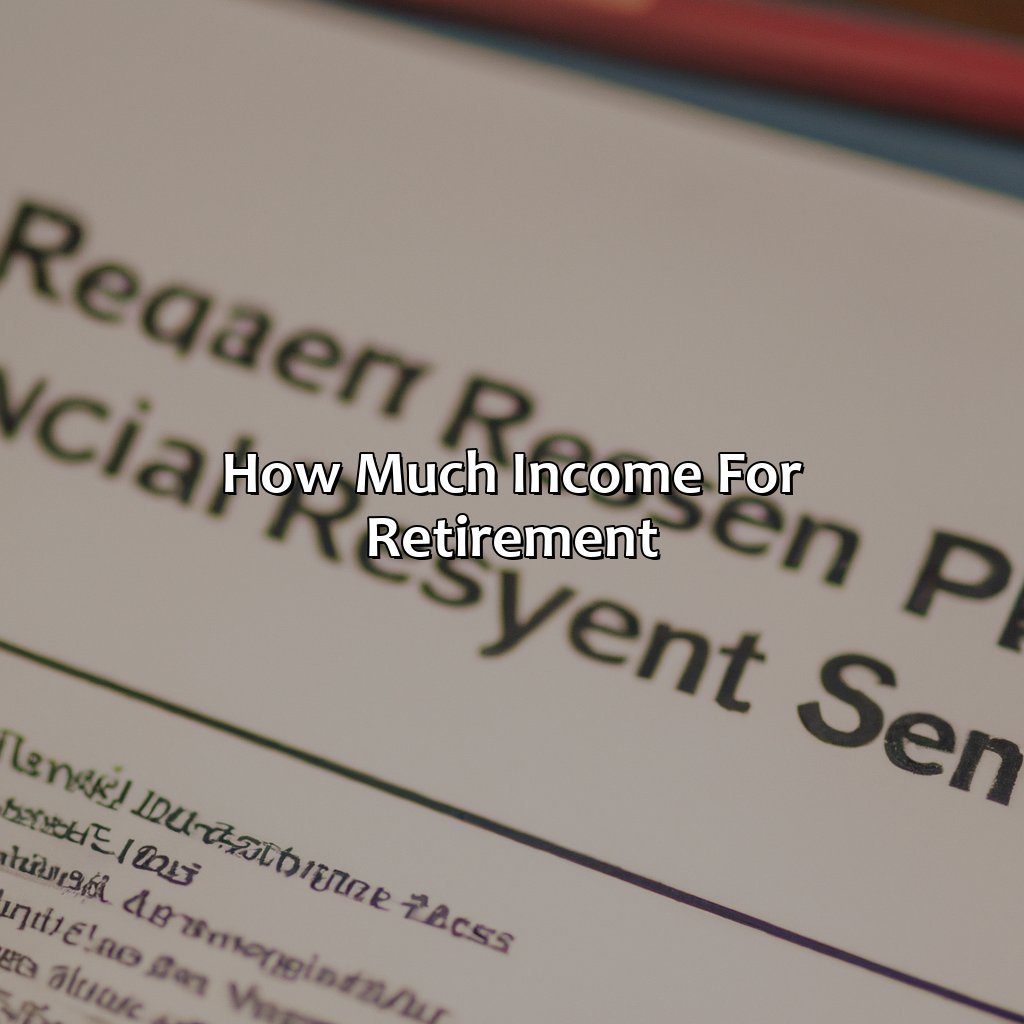How Much Income For Retirement?
Key Takeaway:
- Determining retirement income needs is the starting point for retirement planning, and it requires careful consideration of factors such as lifestyle, inflation, and unexpected expenses.
- Calculating retirement expenses is a crucial step in determining retirement income needs. It involves assessing healthcare, housing, living, tax, and debt payment expenses, and adjusting for expected inflation.
- Estimating retirement income sources is essential to ensure that retirement income needs are met. Sources may include Social Security benefits, pension plans, retirement savings, part-time work income, and rental income. It is important to review and update retirement plans regularly and seek professional guidance to ensure flexibility and adaptability in the retirement income plan.
Are you concerned about having enough money for retirement? You need a realistic plan to ensure a comfortable living after you retire. Discover how to create a retirement income that works for you and your desired lifestyle.
Determining retirement income needs
Retirement Income Planning: Knowing How Much You Need
The essential aspect of retirement planning is determining how much income is needed to maintain your current lifestyle. This can be done by analyzing your current expenses, medical costs, expected inflation rates, and any other relevant factors. Consider sources of retirement income like pension plans, social security benefits, and personal savings. Based on this analysis, you can develop a retirement income plan that will help you reach your retirement goals.
It’s important to analyze your specific financial situation to determine your retirement income needs. You may want to work with a financial advisor or use retirement calculators online to help you reach this determination. While each individual’s situation is unique, it’s crucial to have a clear financial understanding of your retirement needs to avoid inadequate retirement savings.
It’s vital to start thinking about your retirement income needs today. By planning early, you can invest appropriately and take advantage of compound interest. In addition to financial planning, staying healthy, and ensuring adequate healthcare coverage can help you achieve your retirement goals.
Historically, many people underestimated their income needs in retirement, leading to financial hardship. Due in part to longer life expectancies, the current retirement landscape necessitates that you plan for an extended retirement horizon. Begin early, educate yourself, and careful consideration in retirement planning are the first steps towards a sustainable retirement.
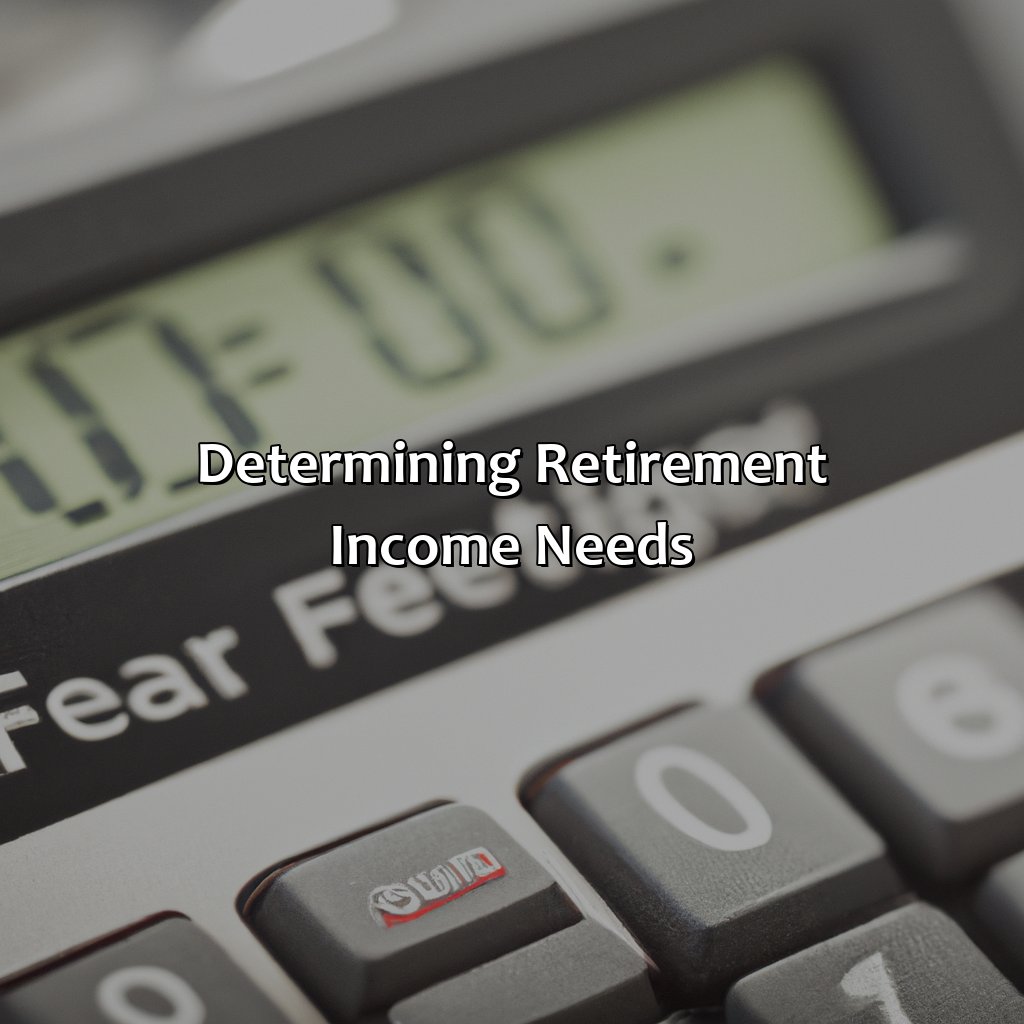
Image credits: retiregenz.com by Joel Washington
Calculating retirement expenses
Calculate your retirement expenses well by getting “Calculating Retirement Expenses”! It gives you a solution for “Healthcare Expenses, Housing Expenses, Living Expenses, Debt Payments, Taxes”.
We’ll guide you through each sub-section to figure out how much money is needed for all of your retirement expenses.
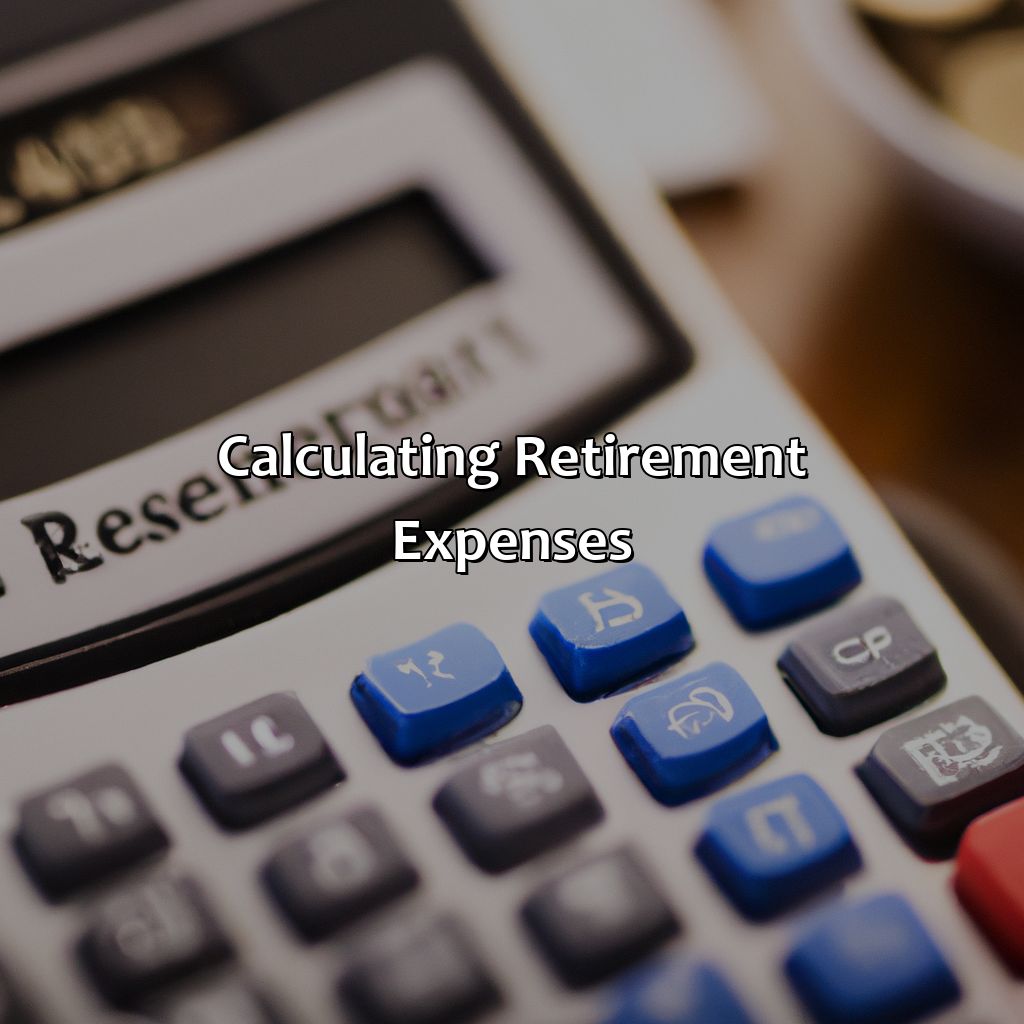
Image credits: retiregenz.com by Yuval Arnold
Healthcare expenses
Planning for future medical costs is a crucial aspect of retirement finances. Expenses related to healthcare can vary widely depending on the individual’s health and lifestyle choices. These include doctor visits, prescription medications, hospital stays, and long-term care in case of chronic ailments or disability.
Furthermore, inflation rates have significantly affected healthcare costs in recent years. It is essential to determine the potential expenses early and account for them while saving for retirement.
Retirees can keep their healthcare costs in check by investing in insurance coverage that includes comprehensive healthcare benefits like Medicare Advantage plans. Such plans provide access to health management resources like wellness programs that could reduce out-of-pocket expenses.
Seniors who need extra assistance with daily living activities must consider hiring professional caregivers or opting for assisted living facilities that offer customizable services catering to the individual’s needs.
In a recent study by Fidelity Investments, an average retired couple aged 65 should plan on spending approximately $300,000 for their healthcare expenses throughout their remaining lifespan.
It is imperative to plan adequately for these expenses as they could significantly affect the financial stability of retirees later in their lives. Hence it is wiser to take steps that assist in minimizing long-term healthcare expenses.
After retirement, downsizing to a cardboard box may become a viable housing option.
Housing expenses
Housing expenditure is a crucial component of retirement expenses that warrants ample attention. The costs of property taxes, homeowners’ insurance, utilities, and mortgage payments are some housing expenses to be factored out.
It is important to reduce expenditure by downsizing or relocating to less expensive areas while also maintaining a comfortable living standard. Renting property rather than owning it may also reduce maintenance and repair costs.
Location determines the cost of housing. Moving to an area with low housing expenses can potentially save money on retirement rentals or mortgages.
Opting for Reverse mortgages may sometimes help generate income without necessarily having to leave the home. However, this may not work in all circumstances as reverse mortgages can have high fees and interest rates.
“Why retire to a beach when you can retire to your mom’s basement and save on rent?”
Living expenses
When planning for retirement, it is crucial to consider the expenses needed for daily living. These costs can include housing, transportation, food, healthcare and other essential expenditures. To ensure a comfortable retirement lifestyle, it’s essential to budget carefully and identify your expected expenses.
It is recommended to estimate future living expenses based on current spending patterns and adjust accordingly for inflation. This calculation can be done through creating a detailed budget or using retirement planning software that factors in various variables such as taxes, social security benefits, and investment returns.
Additionally, considering unforeseen expenses such as emergency medical bills or costly home repairs can mitigate financial stress in the long term. It’s important not to underestimate the impact these unexpected costs can have on one’s finances.
Proper planning and saving today will prevent the fear of missing out on necessary living costs during retirement. By being proactive and anticipating financial needs early, individuals can secure a comfortable retirement lifestyle and ensure their dream life after retirement.
“If debt is a prison, retirement should be a beach vacation.” Time to start breaking free and calculating those expenses!
Debt payments
When calculating retirement expenses, it’s crucial to consider the literal meaning of expenses that come with debt. Understanding the debt may help an individual prioritize how much to save for retirement.
Retirees must set aside extra money for loan repayments and credit card bills as they have high-interest rates. Paying off debts during retirement can be challenging as other costs like healthcare and daily necessities may take priority.
It’s essential to pay attention to mortgage payments during the planning stage, which may impact overall income available for retirement. However, having a large proportion of income going towards debts could be detrimental, affecting other essential needs down the road.
To avoid financial strain in Retirement, retirees need to clear their credit cards and loans before retiring. While saving for emergencies, they should also create a budget that will allow them to live comfortably without incurring any debt during retirement.
Don’t miss out on enjoying your Golden Years because of Debt payments during Retirement. By clearing your debts before retiring, you not only decrease your financial burden but also increase your income available for a happy and comfortable Retirement life.
Whoever said nothing is certain except death and taxes must not have factored in the ever-changing tax laws.
Taxes
As you approach retirement, it’s crucial to factor in the various forms of tax that may impact your expenses. You’ll want to consider federal and state income tax, social security tax, property tax, capital gains tax, and healthcare-related taxes.
When planning for retirement expenses, don’t make the mistake of assuming that you won’t owe any taxes simply because you’re no longer working full time. Depending on your sources of income and level of taxable investments, you may be surprised by the amount you owe.
It’s important to research how different forms of income – such as pensions, investment income, social security benefits, and withdrawals from retirement accounts – will be taxed. Consulting with a financial advisor or tax professional can also provide valuable insights.
In one instance, a retiree assumed that their taxes would decrease significantly since they were no longer employed. However, they failed to account for the taxable portion of their pension plan and were caught off guard by their significantly higher-than-expected tax bill.
Why rely on just a pension when you can also collect coins from fountains and cash in on your cat’s viral videos?
Estimating retirement income sources
Figuring out your retirement income is crucial for planning a financially secure future. Here are the key sources of income that you need to consider:
- Social Security benefits: This is a government program that provides retirees with a monthly income based on their work history. To maximize your Social Security benefits, it’s important to understand how the program works and the best time to start taking benefits.
- Pension plans: Some employers offer pension plans that provide retirees with a monthly income. You need to understand the terms of your pension plan and whether it will cover your retirement expenses.
- Retirement savings: This includes savings in your 401(k) or IRA accounts. You need to calculate how much you will need to save to meet your retirement expenses and the best way to withdraw that money during retirement.
- Part-time work income: Working part-time during retirement can provide you with extra income and also keep you active and engaged. However, you need to consider the effect of part-time work on your Social Security benefits and taxes.
- Rental income: If you own rental property, you can use the rental income to supplement your retirement income. However, you need to consider the expenses associated with owning rental property and whether it’s the right investment for your retirement income.
Knowing the advantages and disadvantages of each source of income can help you make the most of your retirement and plan for a financially secure future.
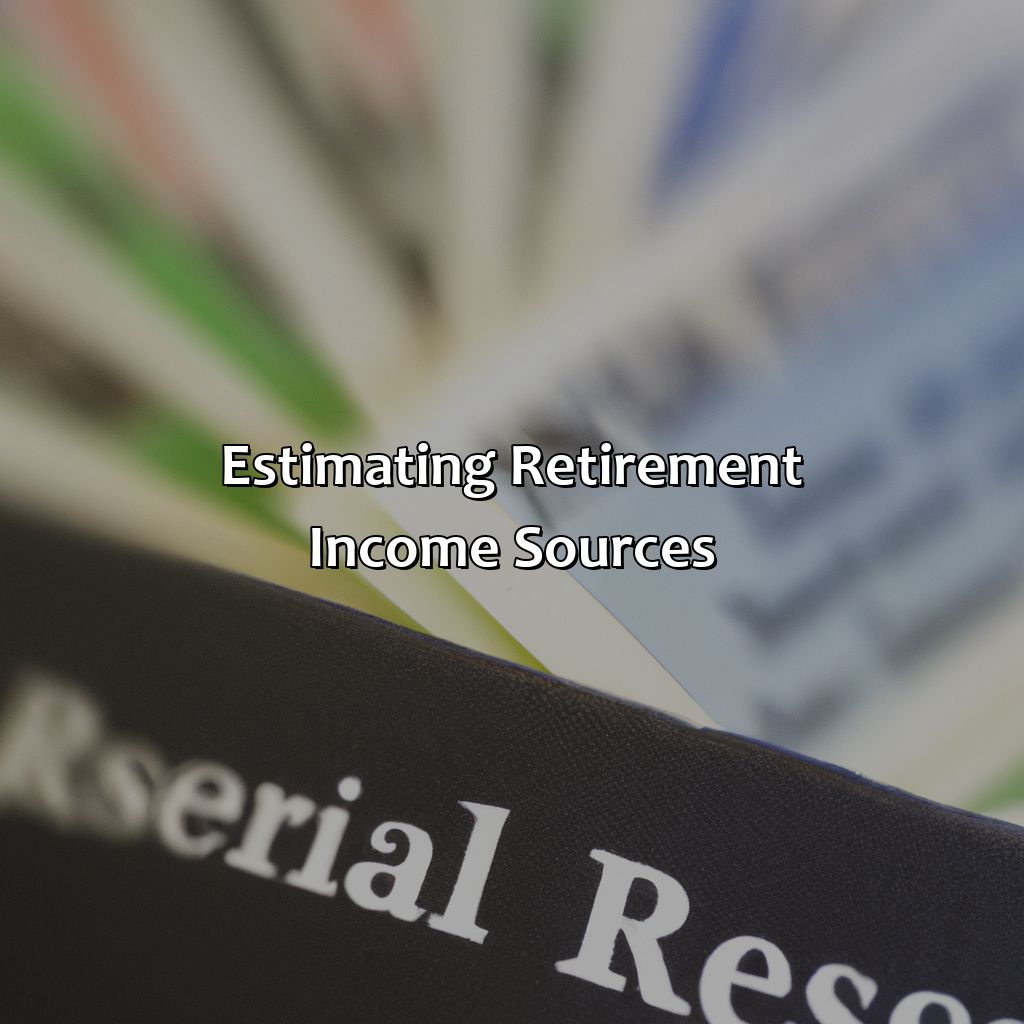
Image credits: retiregenz.com by Yuval Duncun
Social Security benefits
One of the potential sources of retirement income is the government-funded program that provides financial assistance to retirees. This program is known by a literal meaning of ‘Social Security benefits’. It is designed to provide a steady stream of income throughout your retirement years, and the amount you receive varies based on several factors, including how long you’ve worked and how much money you’ve earned over your lifetime.
In addition to the monthly benefit payments which are based on your earnings history, another literal meaning is ‘Social Security spousal benefits’ which may be available if your spouse has paid into the Social Security system, whether or not they have claimed their own benefit. It could be up to half of your spouse’s benefit amount. Furthermore, it’s important to note that if you claim early (at age 62), your benefit will be reduced.
Other than this, it’s critical to consider creating a budget that allows for living expenses during retirement. A useful option could be building passive income streams through investments in stocks or real estate. Dividend stocks provide regular payouts even during market fluctuations, and rental properties generate rental income every month. Alternatively, another literal meaning would be ‘Annuities’ as an insured product in exchange for regular payments typically through life annuities used for longevity risk management.
Taking advantage of these possible sources may help you reach sustainable retirement income goals while being prepared for unexpected surprises during unanticipated emergencies without jeopardizing any other financial plans. Get ready to retire like a boss with a pension plan- it’s like winning the retirement lottery, but without the annoying paparazzi.
Pension plans
When estimating retirement income sources, it is essential to consider the contribution of securing a self-funded pension scheme or corporate-provided annuity as part of your overall plan. Although government-backed pensions are available in many countries, they are not always guaranteed to be enough. The private sector provides diverse options for workplace retirement savings programs, such as employer matching and voluntary payroll deductions that can contribute towards enriching the pension pot and future financial stability.
It’s crucial to anticipate if your projected pension will provide you with a sustainable income level throughout your retirement years. Moreover, with unexpected global market events, preparing for a long-term career pause is becoming increasingly important. Suppose individuals find themselves without any provisions intended towards their old age. In that case, they may have to resort to potentially riskier approaches such as high-risk investments-briefly providing and not considering lifetime requirements-by understanding all personal accounts’ benefits offered by employers starting from the early working years.
Don’t wait until it’s too late to establish a solid foundation for old age monetary security; start considering several diversified options for cash flow enhancement today. By doing so now, you’ll elevate your odds of achieving both short-and-long-term objectives concerning financial well-being while avoiding scenarios blessed with regrets or remorse regarding life decisions made much earlier on.
Retirement savings – because when you’re too old to work, you’re also too old to rely on your parents for pocket money.
Retirement savings
Planning for post-work life can be complex and overwhelming. One aspect of retirement planning revolves around ‘Funds Set Aside for Retirement’. The estimation process mostly involves evaluating how much capital is needed to cover expenses and identifying investment opportunities to ensure long-term financial stability.
There are several ways to create a reliable lump sum of ‘Retirement savings’, which includes employer-sponsored 401(k) plans, Individual Retirement Accounts (IRAs), government pensions, and Social Security benefits. Understanding the different contribution limits, tax implications, withdrawal rules, and benefits associated with each savings option is vital for a secure financial future.
One notable detail about creating ‘Retirement savings’ is starting as early as possible when it comes to investing. Diversifying investments across multiple options also prevents overdependence on any single source of income in retirement.
To maximize the potential of a stable and steady stream of income in retirement, consider consulting an expert or using online calculators to estimate how much money might be required for retired life. Careful planning can help you gain confidence in your ability to enjoy the future without falling into financial distress.
If retirement income was a puzzle, part-time work would be the last missing piece…you know, the one you find under the couch after months of searching.
Part-time work income
Supplementary Earnings for Retirement
One of the additional sources of income for an individual’s retirement plan can be through securing a part-time job. Although it might not generate a substantial amount, It can contribute to maintaining a comfortable lifestyle while living off savings. Depending on the situation and requirements, working part-time can also offset expenditures and act as a source of personal fulfillment.
It is essential to consider one’s physical capabilities and ensure that the job does not exhaust them beyond their capacity. Retirees should look for flexible jobs with adaptable hours and low-stress positions that allow them to maintain life balance. Additionally, identifying current skills that can be applied in the workforce may lead to better employment prospects suitable for retirees.
A report states that on average, individuals who retire earlier are more likely to work during retirement than those who retired later due to longer exposure in the workforce. Moreover, holding part-time positions helps sustain income and provide meaningful activities leading to enhanced well-being over time, according to recent studies.
Recounting a Personal Experience
My grandfather was someone who embraced his retirement post being a successful business owner. However, over time he started experiencing restlessness due to lack of engagement and social interaction. We suggested he take up a part-time position at a community center near our home. The workplace provided him with opportunities that were similar to his social interests; moreover generated acceptable earning sans much stress or workload. The experience transformed his daily routine while offering financial benefits making it an ideal supplement program within an established retirement plan.
“Who needs a roommate when you can have a rental property pay your bills in retirement?”
Rental income
Real estate rental revenue, a potential source of income in retirement. This passive income can be generated by owning rental property or receiving payments as a landlord for leasing out an asset such as office buildings, apartments, or other structures. With cautious planning and management, rental income can supplement retirement funds.
However, managing rental properties can be demanding and time-consuming. Property taxes, maintenance costs, and various duties might decrease the projected revenue from leasing out assets. Another factor to consider is tenant turnover – finding new tenants frequently might negatively impact your recurring income.
In addition to owning rental property outright or utilizing leased assets in return for payment as a landlord, another option could include investing in real estate mutual funds that specialize in real estate investment trusts (REITs). Either approach has its advantages and disadvantages.
Don’t miss out on potential passive income streams with renting real estate investments for a successful retirement plan. In reality letting go of earning opportunities from heavy workload requires strategic planning to secure you financially in retirement. Don’t wait until retirement to start planning your income, unless your retirement plan involves becoming a professional couch surfer.
Ensuring proper retirement income planning
For proper retirement income planning, it is essential to review and update your plan regularly, seek professional advice, and be flexible. These three steps will give you the strong foundation you need for your retirement income plan. This way, you can adjust to life changes and achieve financial success.
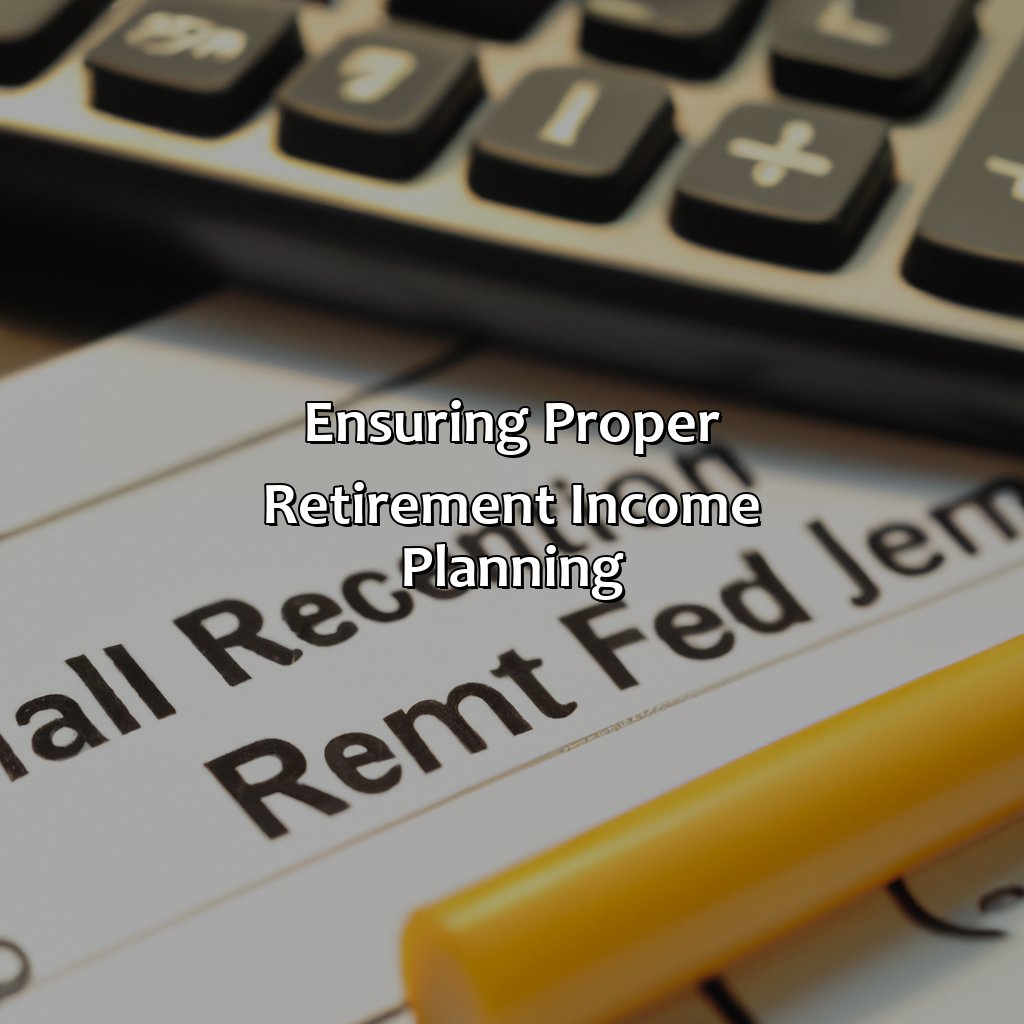
Image credits: retiregenz.com by David Washington
Regular reviewing and updating of retirement plan
It is vital to periodically assess and amend retirement planning strategies to ensure it stays relevant to the changing circumstances. A dynamic review of retirement plans in terms of savings, investment vehicles, pension schemes, and income sources can allow an individual to adjust their expected post-retirement life quality.
Evaluating the effectiveness of investments and schemes for added returns is imperative. Emphasizing a diverse set of investments in stocks, bonds, and real estate could help balance one’s portfolio while minimizing risks. Revisiting risk-averse add-ons like annuities or fixed-term deposits might tie up loose ends.
Constantly accounting for inflation rates, average market indices performance, and other economic factors are necessary updates discussed in regular reviews. The ability to redirect resources as needed ensures reaching short-term goals without compromising on long-term ones.
Pro Tip: Consistent monitoring will give clarity on what should be corrected, discarded or maintained as is in your retirement plan that aligns with your goals today while simultaneously giving a hedge for tomorrow’s uncertainty. Because let’s face it, retirement planning is like navigating a maze blindfolded – sometimes it’s best to seek professional help before hitting a dead end.
Seeking professional guidance
Professional assistance for retirement income planning can make the process of estimating the required retirement income easier. Obtaining assistance from certified financial planners or retirement planning experts who have in-depth knowledge of diverse financial instruments that impact your income and savings can help provide tailored solutions.
The right professional guidance helps you identify potential pitfalls and plan ahead. An advisor can help decide how much of your current salary should go towards saving for retirement, where to invest this money, how inflation impacts your plans etc.
Additionally, these professionals can assist in creating a long-term investment strategy for generations to come. Professional advice on retirement income is especially crucial as unexpected events like illnesses or economic recessions often disrupt even the most well laid out retirement plans.
According to AARP’s research on Retirement Income in 2021, most Americans worry about not having enough money saved, and only 41% have a plan to review expenses and save more.
Flexibility in retirement income plan.
A retirement income plan should have the ability to adapt to changing financial circumstances. It is crucial to incorporate flexibility into the plan to account for unexpected life events such as health issues or changes in market conditions. The flexibility in retirement income planning allows retirees to live comfortably without sacrificing their lifestyle or quality of life.
One way to achieve flexibility is by diversifying the portfolio, incorporating various investment options, and taking a calculated risk approach that balances the need for growth with risk tolerance. Additionally, having contingency plans in place can help retirees adjust their expenses based on changing market conditions.
Retirees also benefit from utilizing tools such as annuities and insurance products that provide a guaranteed stream of income regardless of market performance. This flexibility allows them to continue receiving income, even if other investments do not perform well.
Overall, ensuring flexibility within a retirement income plan enables retirees to achieve their financial goals while maintaining an enjoyable lifestyle. By continuously monitoring and adjusting strategies as necessary, they can avoid financial stress and enjoy a happy retirement.
During the 2008 economic downturn, many retirees suffered significant losses in their portfolios and were forced to downsize their lifestyle drastically. This event highlights the importance of building flexibility into a retirement income plan that accounts for changes in markets and life events. Retirees who planned accordingly through diversification and proper asset allocation were more resilient during this time and could retain their standard of living despite adverse economic conditions.
Some Facts About How Much Income for Retirement:
- ✅ Financial advisors suggest saving at least 15% of one’s annual income for retirement. (Source: NerdWallet)
- ✅ The average retiree needs 70-80% of their pre-retirement income to maintain their standard of living. (Source: U.S. News & World Report)
- ✅ Social Security benefits account for only about 40% of the average retiree’s income. (Source: AARP)
- ✅ The recommended retirement savings goal is to have 25 times one’s annual expenses saved. (Source: Fidelity)
- ✅ Factors such as life expectancy, inflation, and healthcare costs should be considered when determining how much income is needed for retirement. (Source: Investopedia)
FAQs about How Much Income For Retirement?
What is the recommended amount of income for retirement?
The recommended amount of income for retirement varies depending on several factors such as your current annual income, lifestyle, retirement goals and age at retirement. A general rule of thumb is to aim for 70% to 80% of your pre-retirement income to maintain the quality of life you are comfortable with.
How can I calculate how much income I need for retirement?
To calculate how much income you’ll need for retirement, you should consider your retirement goals, your expenses, your sources of income, your desired retirement lifestyle, inflation and taxes. You can use online retirement calculators to help you estimate the amount of money you’ll need to save for retirement.
What are the different sources of income for retirement?
The different sources of income for retirement include social security benefits, pensions, 401(k) plans, IRAs, annuities, investments and savings. Additionally, some individuals may have rental income, dividends, or income from a part-time job during retirement.
How much should I save per year for retirement?
The amount you should save per year for retirement will depend on your current income, how much you have saved already, and your retirement goals. The general rule of thumb is to save 15% of your annual income for retirement.
What strategies can I use to increase my retirement income?
To increase your retirement income, you can consider strategies such as delaying your social security benefits, working part-time during retirement, investing in dividend-paying stocks, and saving more money. You can also speak with a financial advisor to help you create a comprehensive retirement plan.
What are the consequences of not saving enough for retirement?
If you do not save enough for retirement, you may face financial difficulties and may not be able to retire comfortably. You may have to continue working during retirement or rely on family members for financial assistance. It is important to save as much as you can to prepare for your retirement years.
